Olympics history and information, olympic athletes, olympic games and more. Everything you could want to know about the Olympics.
2006 Winter Olympics
| XX Olympic Winter Games | |
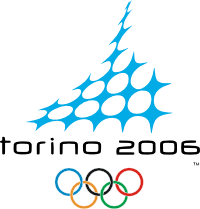 The emblem shows a stylized profile of the Mole
Antonelliana, | |
| Host city | Turin, Italy |
| Nations participating | 80 |
| Athletes participating | 2,508 (1,548 men; 960 women) |
| Events | 84 in 7 sports |
| Opening ceremony | February 10 |
| Closing ceremony | February 26 |
| Officially opened by | Carlo Azeglio Ciampi |
| Athlete's Oath | Giorgio Rocca |
| Judge's Oath | Fabio Bianchetti |
| Olympic Torch | Stefania Belmondo |
| Stadium | Stadio Olimpico |
The 2006 Winter Olympics, officially known as the XX Olympic Winter Games, were celebrated in Turin, Italy from February 10, 2006, through February 26, 2006. This marked the second time Italy hosted the Olympic Winter Games, the first being the VII Olympic Winter Games in Cortina d'Ampezzo in 1956. Italy also hosted the Games of the XVII Olympiad in Rome in 1960. Turin was selected as the host city for the 2006 games in 1999.
The official logo displayed the name "Torino", the Italian name of the city, but the city is known as "Turin" in both English and the local traditional dialect, Piedmontese, although having slightly different pronunciations. The Olympic mascots of Torino 2006 were Neve ("snow" in Italian), a female snowball, and Gliz, a male ice cube. The official motto of the XX Olympic Winter Games was "Passion lives here".
Turin, with a metropolitan area of 1.7 million, is the largest city to have ever hosted a Winter Olympics; the title will fall to Vancouver, British Columbia, Canada, (2.1 million) when that city hosts the XXI Olympic Winter Games. The 2002 Salt Lake City games also claims this title because at the time of the Olympics its metropolitan population was 1,516,227 and some events were held in the Provo metropolitan area of 400,209, which the state of Utah calls a single metropolitan area of 1.9 million and the U.S. government describes as two metropolitan areas in a single urban area.
Contents |
The Games featured 84 medal events in 15 disciplines grouped over 7 sports. Events that made Olympic debut in Turin included mass start biathlon, team sprint cross country skiing, snowboard cross and team pursuit speedskating. The classical men's 50 km and women's 30 km distances, which were held at the previous Winter Games in 2002, were not held in these Games, as these events were alternated with freestyle events of the same distances; In fact, most of the cross country skiing events at these Games involved different distances from those in Salt Lake City.
The following are the disciplines that were contested at the games.
Results
| Rank | Nation | Gold | Silver | Bronze | Total |
|---|---|---|---|---|---|
| 1 | 12 | 6 | 29 | ||
| 2 | 9 | 9 | 7 | 25 | |
| 3 | 9 | 7 | 7 | 23 | |
| 4 | 8 | 6 | 8 | 22 | |
| 5 | 7 | 10 | 7 | 24 | |
| 6 | 7 | 2 | 5 | 14 | |
| 7 | 6 | 3 | 2 | 11 | |
| 8 | 5 | 4 | 5 | 14 | |
| 9 | 5 | 0 | 6 | 11 | |
| 10 | 3 | 2 | 4 | 9 | |
| 3 | 2 | 4 | 9 |
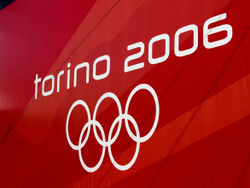
Athletes with the most gold medals
 Michael Greis (GER)
(Biathlon): 3 gold medals
Michael Greis (GER)
(Biathlon): 3 gold medals
 Ahn Hyun Soo (KOR)
(Short track speed skating): 3 gold medals
Ahn Hyun Soo (KOR)
(Short track speed skating): 3 gold medals
Jin Sun-Yu (KOR) (Short track speed skating): 3 gold medals
Athletes with the most medals
 Cindy Klassen (CAN)
(Speed skating): 5 (1 gold, 2 silver, 2 bronze)
Cindy Klassen (CAN)
(Speed skating): 5 (1 gold, 2 silver, 2 bronze)
 Ahn Hyun Soo (KOR)
(Short track speed skating): 4 (3 gold, 1 bronze)
Ahn Hyun Soo (KOR)
(Short track speed skating): 4 (3 gold, 1 bronze)
Nations with medals in most disciplines
 Canada:
10 disciplines, 21 events
Canada:
10 disciplines, 21 events
 United States: 9 disciplines, 21 events
United States: 9 disciplines, 21 events
 Finland:
8 disciplines, 9 events
Finland:
8 disciplines, 9 events
 Germany:
7 disciplines, 25 events
Germany:
7 disciplines, 25 events
 Russia:
7 disciplines, 21 events
Russia:
7 disciplines, 21 events
 Norway:
7 disciplines, 15 events
Norway:
7 disciplines, 15 events
 Switzerland:
7 disciplines, 13 events
Switzerland:
7 disciplines, 13 events
Medal sweep events
 Austria:
3/3 medals in Men's Slalom
Austria:
3/3 medals in Men's Slalom
 Germany:
3/3 medals in Women's single luge
Germany:
3/3 medals in Women's single luge
For team sports, the following countries won a medal in both men's and women's events:
 Canada:
curling;
short
track speed skating relay; Speed
skating team pursuit
Canada:
curling;
short
track speed skating relay; Speed
skating team pursuit
 France:
biathlon
relay
France:
biathlon
relay
 Germany:
biathlon
relay; Cross
country skiing relay
Germany:
biathlon
relay; Cross
country skiing relay
 Italy:
Cross
country skiing relay
Italy:
Cross
country skiing relay
 South Korea: short
track speed skating relays
South Korea: short
track speed skating relays
 Russia:
biathlon
relay
Russia:
biathlon
relay
 Sweden:
Cross
country skiing team sprint; Ice
hockey
Sweden:
Cross
country skiing team sprint; Ice
hockey
The only occasions where both golds were won by the same country were South Korea in the short
track speed skating relays and
![]() Sweden
in Cross
country skiing team sprint.
Sweden
in Cross
country skiing team sprint.
Calendar
| o | Opening ceremony | o | Event competitions | o | Event finals | o | Exhibition gala | o | Closing ceremony |
| February | 10th | 11th | 12th | 13th | 14th | 15th | 16th | 17th | 18th | 19th | 20th | 21st | 22nd | 23rd | 24th | 25th | 26th |
|---|---|---|---|---|---|---|---|---|---|---|---|---|---|---|---|---|---|
| Ceremonies | o | o | |||||||||||||||
| Biathlon | o | o | o | o | o o | o | o | o o | |||||||||
| Bobsleigh | o | o | o | o | o | o | |||||||||||
| Curling | o o o | o o o | o o o | o o o | o o o | o o o | o o o | o o o | o o | o o | o o | ||||||
| Ice hockey | o o | o o | o o | o o | o o | o o | o | o o | o o | o o | o o | o | o | o | o | ||
| Figure skating | o | o | o | o | o | o | o | o | o | o | |||||||
| Cross-country skiing | o o | o o | o | o | o | o | o o | o | o | ||||||||
| Nordic combined | o | o | o | o | |||||||||||||
| Luge | o | o | o | o | o | ||||||||||||
| Speed skating | o | o | o | o | o o | o o | o | o | o | o | o | o | |||||
| Short track | o | o | o o | o | o o o | ||||||||||||
| Alpine skiing | o | o | o | o | o | o | o | o | o | ||||||||
| Freestyle skiing | o | o | o | o | o | o | |||||||||||
| Ski jumping | o | o | o | o | o | ||||||||||||
| Skeleton | o | o | |||||||||||||||
| Snowboarding | o | o | o | o | o | o | |||||||||||
| February | 10th | 11th | 12th | 13th | 14th | 15th | 16th | 17th | 18th | 19th | 20th | 21st | 22nd | 23rd | 24th | 25th | 26th |
Highlights
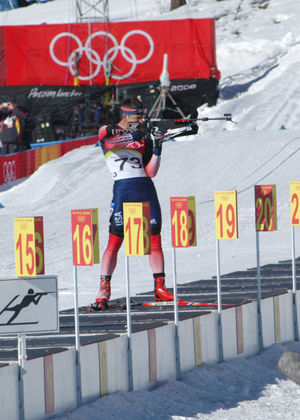
Opening Ceremony
Stefania Belmondo, a 10-time Olympic medalist in cross-country skiing, lit the Olympic Flame during the opening ceremony on 10 February. Before that, the ceremony celebrated the best of Italy and Sport including a segment honoring the Alps.
Day 1
The first gold medal of the 2006 Games was awarded in the 20 kilometre biathlon, won by German Michael Greis on the first day of competition. Ice hockey began with the women's competition; Sweden defeated Russia 3-1 in the first match while Canada's team opened with the most lopsided win in Olympic history by beating the host Italians 16-0.
Day 2
On 12 February, Latvia won its first winter Olympic medal when Martin Rubenis took the bronze in the men's luge. Armin Zöggeler's win in that event gave Italy its first gold medal of the Games. Both the Canadian and American women's ice hockey teams posted their second straight shutout wins.
Day 3
Chinese figure skating pair Zhang Dan and Zhang Hao, trailing a dominant Russian pair, attempted a throw quadruple salchow jumps — an element which had never been successfully completed in competition. Zhang Dan fell, injuring her knee, but the pair finished their program to a standing ovation and took the silver medal. Russia finished the third day of competition with two gold medals, as did the United States.
Day 4
The fourth day saw the two North American women's hockey teams finish out pool play with their third win each. Evgeni Plushenko of Russia set a world record score in the men's figure skating short program; his 90.66 points was more 10 points better than the nearest opponent's score. The men's combined alpine skiing was riddled with disqualifications, including front-runners Bode Miller and Benjamin Raich. American Ted Ligety won the event in what was considered an upset.
Day 5
Canada had another strong day on 15 February, setting new Olympic records in both men's and women's pursuit team speed skating events as well as opening the men's ice hockey competition with a win against Italy. Italy finished the day with the men's pursuit team Olympic record, however, after the Netherlands bettered Canada's time only to have Italy improve upon theirs. China won its first gold of 2006 with Wang Meng's victory in the women's individual 500 metre short track speed skating. A pair of Austrian brothers won the men's doubles luge while Michaela Dorfmeister gave the nation another championship in the women's downhill.
Day 6
Kristina Šmigun won her second gold medal of the Games with a victory in the women's 10 kilometre classical cross-country skiing on 16 February, remaining the only Estonian to medal. In men's curling action, Great Britain edged Germany 7-6, Switzerland kept New Zealand winless by winning 9-7, Canada beat Norway 7-6, and the United States defeated Sweden, 10-6.
Day 7
On February 17, Tanja Frieden of Switzerland took the gold in women's snowboard cross after Lindsey Jacobellis of the United States fell on the second-to-last jump while performing an unnecessary method grab to give up the largest lead of the entire tournament. Jacobellis settled for silver, while Canada's Dominique Maltais took bronze after recovering from a crash. Duff Gibson of Canada took gold in the skeleton just ahead of fellow Canadian Jeff Pain, becoming the oldest individual gold medalist in Winter Olympics history. In the women's ice hockey semifinals, the United States lost a shootout to Sweden, marking the first time in international competition that the United States had lost to anyone other than Canada (Canada's win maintained its record of never having lost to anyone other than the United States).
Day 8
Kjetil André Aamodt won gold for Norway in the men's Super G on 18 February, beating Hermann Maier of Austria. Germans Kati Wilhelm and Martina Glagow finished first and second in the 10 kilometre biathlon pursuit. The host Italians defeated Canada in men's curling, while Switzerland did the same in men's ice hockey to put the Canadians on the wrong end of two major upsets in the same day. The United States men's ice hockey team suffered its first loss of the tournament as Slovakia and Russia continue their dominance of the pool.
Day 9
Lascelles Brown became the first Jamaican-born competitor to win a medal at the Winter Olympics on 19 February, competing on the Canadian 2-man bobsleigh team which finished second in an extremely tight competition. The German pair was only .21 seconds ahead of the Canadians, themselves only .14 ahead of the Swiss team. Finland continued to be unbeaten in men's ice hockey, handing Canada its second loss.
Day 10
The final day of curling pool play was 20 February; Norway, Sweden, Switzerland, and Canada advanced to the women's semifinals while Finland, Canada, the United States, and Great Britain qualified in the men's competition. Austria took their first team gold medal in ski jumping, while Canada took their second in women's ice hockey to take a 2-1 lead over the United States in all-time Olympic championships.
Day 11
Slovakia and Finland both won their final men's ice hockey games on 21 February to win their respective pools with 5-0-0 records. Enrico Fabris gave the host nation another gold medal in speed skating by winning the men's 1500 metres.
Day 12
On 22 February, the twelfth day of competition, Anja Pärson won her first gold medal in the women's slalom; it was her fifth overall Olympic medal and third of the 2006 Games. Chandra Crawford took a quicker route to the top of the podium, winning the 1.1 kilometre cross-country sprint gold in her Olympic debut. In the men's ice hockey quarterfinals, the previously undefeated Slovakians lost to the Czech Republic while Russia, Finland, and Sweden eliminated Canada, the United States, and Switzerland, respectively. Philipp Schoch successfully defended his snowboarding giant slalom gold against his brother Simon.
Day 13
Sweden took the women's championship in the curling finals held on 23 February. Shizuka Arakawa gave Japan its first gold medal of the Games and first figure skating gold medal, winning the ladies' figure skating competition in part by being able to finish without falling, as Sasha Cohen and Irina Slutskaya both tumbled. Russia wrested the gold medal in women's team biathlon from two-time defending champions Germany.
Day 14
February 24 was the day of the men's curling finals, in which Canada won its first gold medal and the United States won its first medal in the sport as Canada defeated Finland and the United States beat Great Britain for the second time. The figure skating gala was also held, with top placers in all of the events performing exhibitions. Sweden and Finland won their men's ice hockey semifinal games, defeating the Czech Republic and Russia.
Day 15
The Austrians swept the men's alpine slalom medals on 25 February, led by Benjamin Raich. Germany took gold medals in the men's 15 kilometre biathlon and the men's individual bobsleigh. Apolo Anton Ohno won his second short track speed skating gold medal, with only somewhat less controversy than his first 4 years earlier.
Day 16
The final day of competition and the closing ceremony, were held on 26 February. The Swedish men's ice hockey team handed Finland their first loss in the final to take the gold medal. In the closing ceremony, Manuela Di Centa, a seven-time Olympic medalist from Italy and then-member of the International Olympic Committee, was scheduled to present the medals for the men's 50 kilometre cross-country skiing event. This resulted in her presenting the gold medal to her own brother when Giorgio Di Centa won the event to take his second gold medal.
Venues
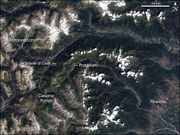
Olympic areas
Olympic events were mainly held in Turin, but other events (namely skiing, snowboarding, and the track sports) were held in mountainous outlying villages for obvious reasons.
Turin
Many venues are located in the Olympic District in central Turin, including:
- Oval Lingotto - Speed skating
- Torino Esposizioni - Ice hockey
- Palasport Olimpico - Ice hockey
- Stadio Olimpico - Opening and closing ceremonies
- Palavela - Figure skating, short-track speed skating
- Olympic Village
Other locations
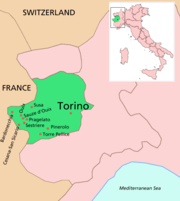
- Bardonecchia, located in Alta Val di Susa, was the site of the snowboarding competitions. An Olympic Village is also located in Bardonecchia.
- Cesana Pariol was the competition site for luge, bobsleigh, and skeleton.
- Cesana-San Sicario was the site of biathlon and alpine skiing events.
- Pinerolo, a town of 35,000, located 50 km from Turin, was the host of curling events.
- Pragelato was the site of cross-country skiing, ski jumping, and nordic combined competitions.
- Sauze d'Oulx, a resort located 80 km from Turin, was the host of the freestyle skiing events.
- Sestriere, located 100 km from Turin, was the site of alpine skiing events. An Olympic village is also located in Sestriere.
Olympic villages
- Bardonecchia
- Sestriere
- Turin
Official Olympic training sites
- Chiomonte
- Claviere
- Prali
- Alpe Lusentino - Domodossola (VB) (Alpine Skiing)
- Riale - Formazza (VB) (Nordic Skiing)
Olympic mountain training site
- Torre Pellice
Participating NOCs
A record of 80 National Olympic Committees (NOCs) entered athletes at the 2006 Winter Olympic Games. This was an increase of three from the 77 represented at the 2002 Olympic Winter Games. The number in parentheses indicates the number of participants that NOC contributed.
|
|
|
|
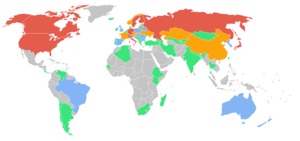
Despite the overall increase of NOCs and number of athletes, the following NOCs which competed at the previous Winter Games did not participate in Turin:
 Cameroon
Cameroon
 Fiji
Fiji
 Jamaica
Jamaica
 Mexico
Mexico
 Puerto Rico
Puerto Rico
 Trinidad and Tobago
Trinidad and Tobago
Turin was chosen as the host of the Olympics in 1999, defeating Sion in Switzerland by 53 votes to 36. This was just after the International Olympic Committee had adopted new election procedures during the 108th Extraordinary IOC Session in light of the corruption scandals surrounding the votes for the 1998 and 2002 Winter Olympics. Since IOC members were forbidden to visit the candidate cities (in the interests of reducing bribery), the 109th IOC Session elected a special body, the Selection College, to choose finalist cities from the pool of candidate cities after each had made their final presentations to the full IOC Session; the full IOC Session then voted on the cities chosen as finalist cities by the Selection College. Although six cities launched candidacies and made presentations to the full IOC Session in Seoul in June 1999, the Selection College chose only two ci Session: Sion and Turin. The candidacies of Helsinki, Finland; Poprad-Tatry, Slovakia; Zakopane, Poland; and Klagenfurt, Austria were dropped by the Selection College after all six candidate cities made their candidate presentations to the full session.
The selection of Turin over Sion came as a surprise, since Sion was the overwhelming favorite. Media speculation was that the choice of Turin was due to the combination of four factors: Turin's overwhelming population size difference (Turin had a population 1.5 million, whilst Sion's was only 27,000), the skills of the Italian bid team, the IOC's desire to compensate Italy for the recent selection of Athens over Rome for the 2004 Summer Olympics, and finally a way to retaliate against Switzerland for the whistleblower role played by IOC member Marc Hodler in the revelation of the 2002 corruption scandal.
Organization
Out of 40,000 applicants, 20,000 volunteers were selected to help the athletes, spectators, and journalists, and to prepare the competition sites. They were selected by the recruiting program Noi2006.
Construction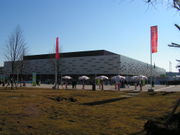
Sixty-five sporting facilities, various infrastructures, sport villages for athletes and media, and transportation infrastructures were constructed for a total of 1.7 billion euros.
Among the most important sporting facilities that were used:
- The Stadio Olimpico (Turin) (formerly known as Stadio Comunale);
- 5 sports halls (3 new, 2 rearranged): the "Palazzo a Vela" re-designed by Gae Aulenti (to host short track and ice skating), the Oval Lingotto (speed ice skating), Torino Esposizioni (ice hockey), the Ice stadium in corso Tazzoli, the Palasport Olimpico designed by Arata Isozaki (ice hockey);
- The Olympic arch of Turin;
- Olympic villages of Turin, Bardonecchia and Sestriere;
- The ice stadium in Pinerolo, re-arranged and enlarged, to host the curling competition;
- A new stadium in Torre Pellice (ice hockey);
- 12 new intermediate-level ski lifts in Cesana Torinese, Cesana San Sicario, Sestriere, Bardonecchia, Claviere, Sauze d'Oulx, Pragelato;
- The tracks for bobsled, luge, and skeleton in Cesana (the second international track in Italy, along with the one in Cortina d'Ampezzo);
The most important transport infrastructure works were:
- The Turin Metro (VAL system), which for the Olympic games connected Collegno to the railway station of Porta Susa.
- The upgrade of 11 state roads and motorways connecting Turin with other Olympic sites.
In the city, from the urban point of view, the main developments were the Palafuksas, a glass building designed by Massimiliano Fuksas, the n the great project of the "Spina", that will provide urban regeneration over an area of 2 million square meters through the construction of an underground urban railway and the re-utilization of abandoned industrial areas.
Olympic problems
The Games had several problems, including possible bankruptcy, doping, and poor ratings.
Bankruptcy threats
The financial situation of the Organizing Committee has gradually become more and more difficult. The latest development was a 64 million euro financial shortfall appearing at the end of 2005, mainly due to the fact that Italy's draft budget for 2006 did not include the government's promised final 40 million euro allocation to Olympic organizers. This shortfall could have led the Torino 2006 Games to declare bankruptcy. The concerns went as far as starting to define the first step of a bankruptcy procedure for Torino 2006, which could have happened if the organizing committee had failed to approve its budget at a January 20, board meeting. Finally, the Italian Government promised to cover the shortfall.
Metro
The metro was finally opened to the public on February 4, 2006 after a 45 day delay. It operated on a shorter stretch (XVIII Dicembre (Porta Susa) to Fermi - 11 stations) than originally forecast; it finally reached the main railway station (Porta Nuova) and the rest of the city centre more than one year after the Games, in October 2007. For the duration of the Games, a single ticket (5 euros) covered use of both the metro and other means of public transportation for a whole day. However, during the Games, metro service stopped at 6:00 pm, making it impractical for spectators of evening events. Furthermore, the metro did not reach any of the Olympic venues. On the other hand, the bus service was heavily improved for the Games, although still inadequate at night hours.
Weather
A number of Alpine competitions were delayed because of low visibility caused by snowfall. Despite these events being postponed, most were later held in better weather without any problems.
Doping
Italian police raided the Austrian athletes' quarter in search of evidence of doping. The raid was conducted due to suspicions over the presence of biathlon coach Walter Mayer, who had been banned from all Olympic events up to and including the Vancouver Olympic Games in 2010 due to previous doping convictions. Around the time of the raid Mayer and two Austrian biathletes, Wolfgang Perner and Wolfgang Rottmann, tried to escape and fled back to Austria. Later, the Austrian ski federation president said that the two athletes told him they "may have used illegal methods." After some days the results of the tests of all 10 tested Austrian athletes were presented and were all negative. List of athletes with doping convictions in these Games:
- Russian Olga Pyleva was stripped of her silver medal in 15 km biathlon event after testing positive for carphedon.
- Brazilian bobsled athlete Armando dos Santos, ejected from the Games after a preventive antidoping test came positive (the results were from a test conducted in Brazil).
Ratings and attendance
A number of events reported low spectator attendance despite having acceptable ticket sales. Preliminary competition and locally less popular sports failed to attract capacity crowd as expected. Organizers explained this was because blocks of seats were reserved or purchased by sponsors and partners who later did not show up at the events.
Several news organizations reported that many Americans are not as interested in the Olympics as in years past. It has been suggested that reasons for this disinterest include the tape delayed coverage, which showed events in prime-time as much as 18 hours later in the West, and also due to the lack of success achieved by big-name American athletes.
In Canada, CBC's coverage has also posted disappointing numbers, which were r competition. Primetime ratings reached only as high as #7 in the weekly ratings. However, ratings for live, afternoon coverage have attracted 300,000 more viewers than the taped, primetime coverage. Overall, only primetime coverage has suffered, dropping 45% from the 2002 Games, with the entire coverage being 52% ahead from 2002. Meanwhile on TSN, the numbers for its live curling coverage (which aired as early as 3:00am EST) were between 300,000 and 500,000 viewers.
The Olympics' main threat in the USA was the 2006 season of American Idol. One night of interest was 23 February in which the first results show of the season went head to head with that night's coverage which included the Women's Free Skate in Figure Skating.
Security measures
As with every Olympics since the 1972 Olympics in Munich and increasingly since the 2002 Winter Olympics, there was heavy security due to fears of terrorism.
The organizers further increased security measures in connection with the Jyllands-Posten Muhammad cartoons controversy and insisted that the Olympic Games were going to be safe, which they were; the Olympics concluded without a major breach of security occurring.